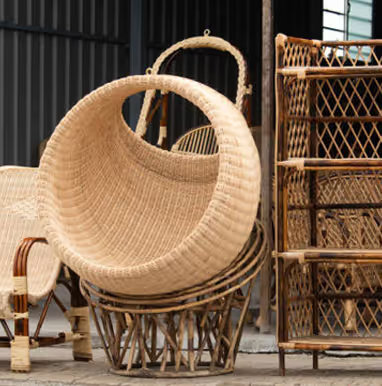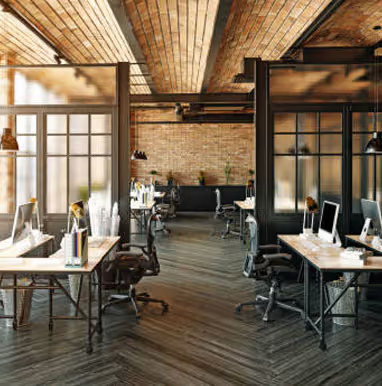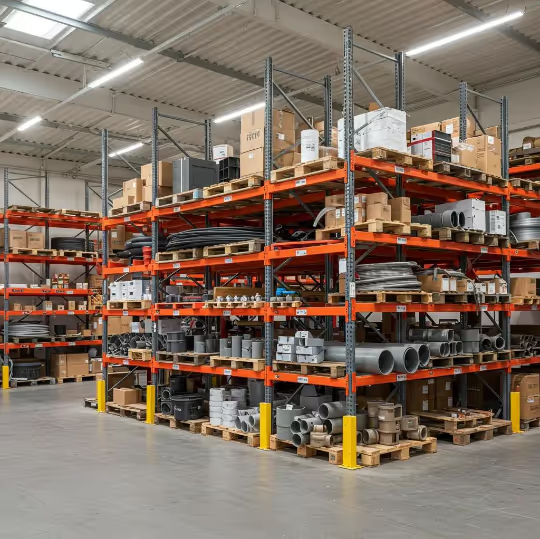
Selecting the ideal material for pallet racking determines whether inventory stays organised, protected, and accessible under heavy loads. Diverse inventories often include items with varied weights, shapes, and sensitivities that demand specific resistance to moisture, chemicals, and abrasion. This guide reveals why material choice matters, explores the strengths of steel, galvanised and stainless options, contrasts powder-coated, aluminum, plastic, and wood variants, and offers a decision framework plus accessory recommendations. Warehouse managers and Skyteck Online specialists will find actionable insights on load capacities, durability, compliance, and future trends to optimise storage systems for any business.
Why Is Material Selection Important for Pallet Racking in General Storage?
Choosing the right frame and beam material for pallet racking defines overall system longevity, safety, and cost-effectiveness in warehouses. Material selection influences structural integrity under variable loads, resistance to moisture and chemical exposure, and maintenance demands. A suboptimal choice can lead to damaged products or rack failure that interrupts operations and increases replacement costs.
Material choices also shape warehouse safety and organisation. Corrosion-prone steels accelerate deterioration when storing items in humid or chemically active environments. Lightweight materials may look appealing but risk overloading when racks support heavy goods. Proper material selection aligns load capacity with environmental conditions and inventory characteristics, ensuring supplies remain intact and accessible.
Key considerations for businesses include:
- Matching material tensile strength to typical product weights
- Prioritising corrosion resistance in wet, humid, or chemical-exposed areas
- Balancing upfront cost against long-term maintenance and lifespan
- Ensuring compliance with safety standards for rack design and spacing
What Unique Challenges Do Diverse Inventories Present for Pallet Racking?
Diverse inventories feature irregular shapes, varied weights, and sensitive finishes that racking structures must support without deformation or abrasion. Items can concentrate load stress along narrow contact points, requiring beam surfaces that distribute weight evenly. Coatings and finishes on products may be damaged by rough metal edges or corrosive rack materials.
Chemical residues from stored goods or cleaning solvents pose additional rack corrosion risks. Prolonged exposure to alkaline or acidic compounds accelerates rust formation on unprotected steel racks. Inventory also demands rapid access and reconfiguration to accommodate custom orders, so racking materials must retain strength after repeated adjustments and moderate impacts from forklifts.
Understanding these challenges guides the choice of rack material and finish. Durable substrates with protective coatings or inherently corrosion-resistant alloys help maintain structural integrity and preserve inventory conditions under demanding warehouse workflows.
Which Factors Should Businesses Consider When Choosing Racking Materials?
When evaluating material for pallet racking for general storage, businesses should assess durability, corrosion protection, load capacity, cost, and safety compliance. Durability ensures that frames and beams resist bending, fatigue, and impacts over years of use. Corrosion protection from galvanising, powder coating, or alloy selection guards against moisture, chemicals, and temperature fluctuations common in warehouse environments.
Load capacity must exceed the heaviest combined weight of items per rack level, including dynamic forces from handling. Initial material cost should be weighed against potential maintenance, replacement frequency, and downtime expenses. Finally, racking systems must meet regional and industry safety standards, such as RMI design specifications and OSHA clearance requirements, to protect personnel and inventory.
By scoring these factors against each candidate material, operations can identify the optimal pallet racking solution that balances performance, lifespan, and budget constraints.
What Are the Advantages of Steel Pallet Racking for Warehouses?
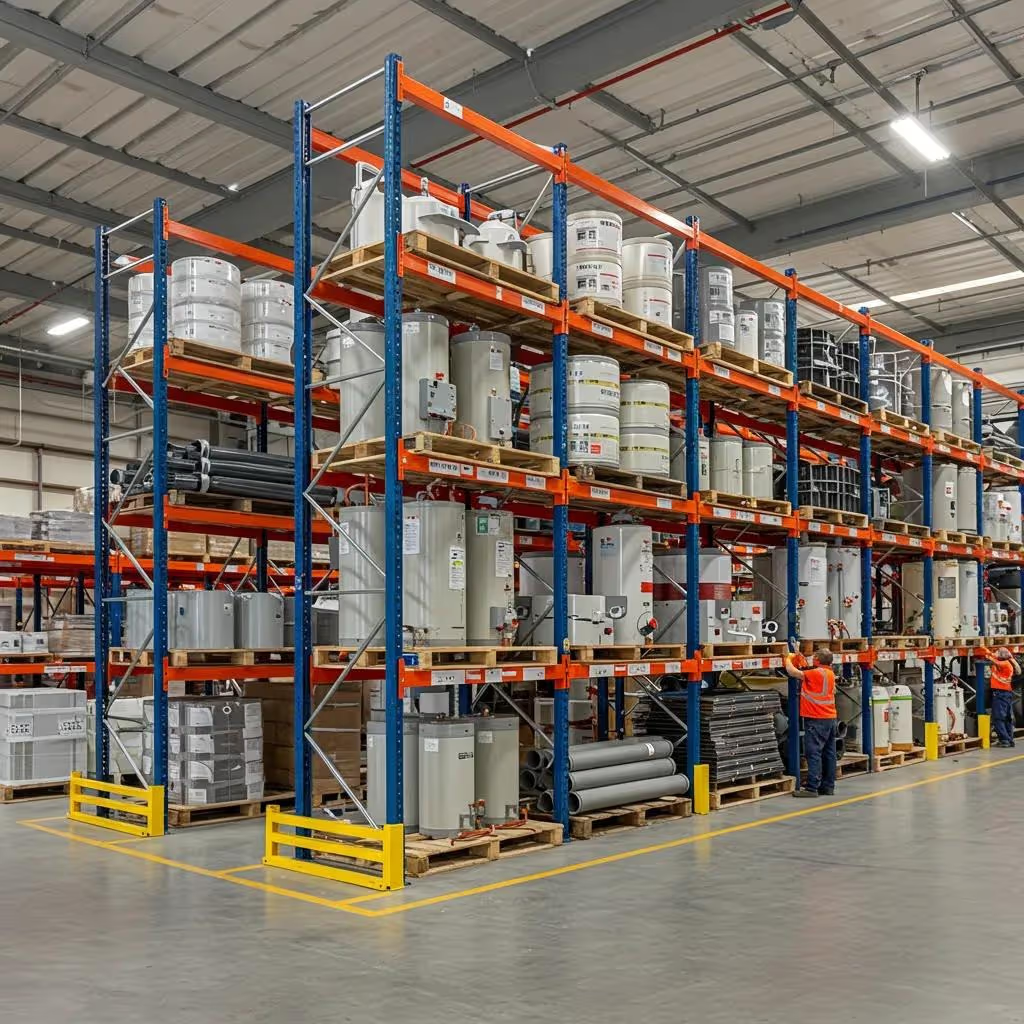
Steel pallet racking delivers exceptional strength and reliability for general supply storage by combining high load capacity with predictable performance under heavy use. Structural or roll-formed steel frames provide the tensile strength needed to support bundles of heavy items, furniture, and equipment without bending or buckling. This reliability reduces the risk of inventory damage and rack collapse.
Beyond raw strength, steel racks enable modular customisation and ease of installation. Welded frame components and beam-clip connections allow rapid reconfiguration to match evolving inventories. Skyteck Online’s steel solutions include bolt-together assemblies optimised for heavy materials, ensuring fast deployment and scalable expansion as business needs grow.
How Do Mild Steel and High-Strength Steel Compare for General Storage?
In warehouses, mild steel racks offer a cost-effective baseline strength, while high-strength steel extends capacity for heavier assemblies and bulk stock. A comparison of core attributes illustrates their respective roles:

The use of cold-reduced steel, a variant of mild steel, offers increased yield stress but reduced ductility, a characteristic that has been successfully managed in manufacturing without compromising service life.
Cold-Reduced Steel for Pallet Racking: Considerations of Strength and Ductility
This relatively hard material is produced by subjecting conventional coil material to cold reduction before forming it into beams, columns, and other components. The advantage of this process is a significant increase in yield stress, but the drawback is a considerable reduction in ductility. Historically, codes of practice for the design of cold-formed sections have generally mandated that the coil material possess a specified level of ductility prior to forming. The scientific rationale behind these ductility requirements is unclear, but code drafting committees have been hesitant to remove them without compelling justification. Nevertheless, steels with very low ductility have been utilised for many years in the manufacture of cold-formed steel components by the two major UK storage rack manufacturers without any issues arising during either production or service due to this lack of ductility.
Pallet Racking Using Cold-reduced Steel, 1994
What Load Capacities and Durability Do Steel Racks Offer for Diverse Components?
Steel pallet racks typically support 3,000 to 8,000 pounds per shelf level, depending on frame section modulus and beam configuration. Robust frame gussets and cross-bracing distribute weight evenly, preventing point loads that can damage products. Over a service life of 10–15 years, quality steel racking retains dimensional stability under frequent loading and unloading cycles.
Key durability benefits include:
- Resistance to permanent deformation under rated loads
- Predictable performance metrics documented by rack manufacturers
- Compatibility with protective finishes to prolong lifespan in humid or chemical-exposed environments
These characteristics ensure inventories remain safeguarded while reducing the frequency of rack repair or replacement.
How Does Galvanised Steel Enhance Pallet Racking for General Supplies?
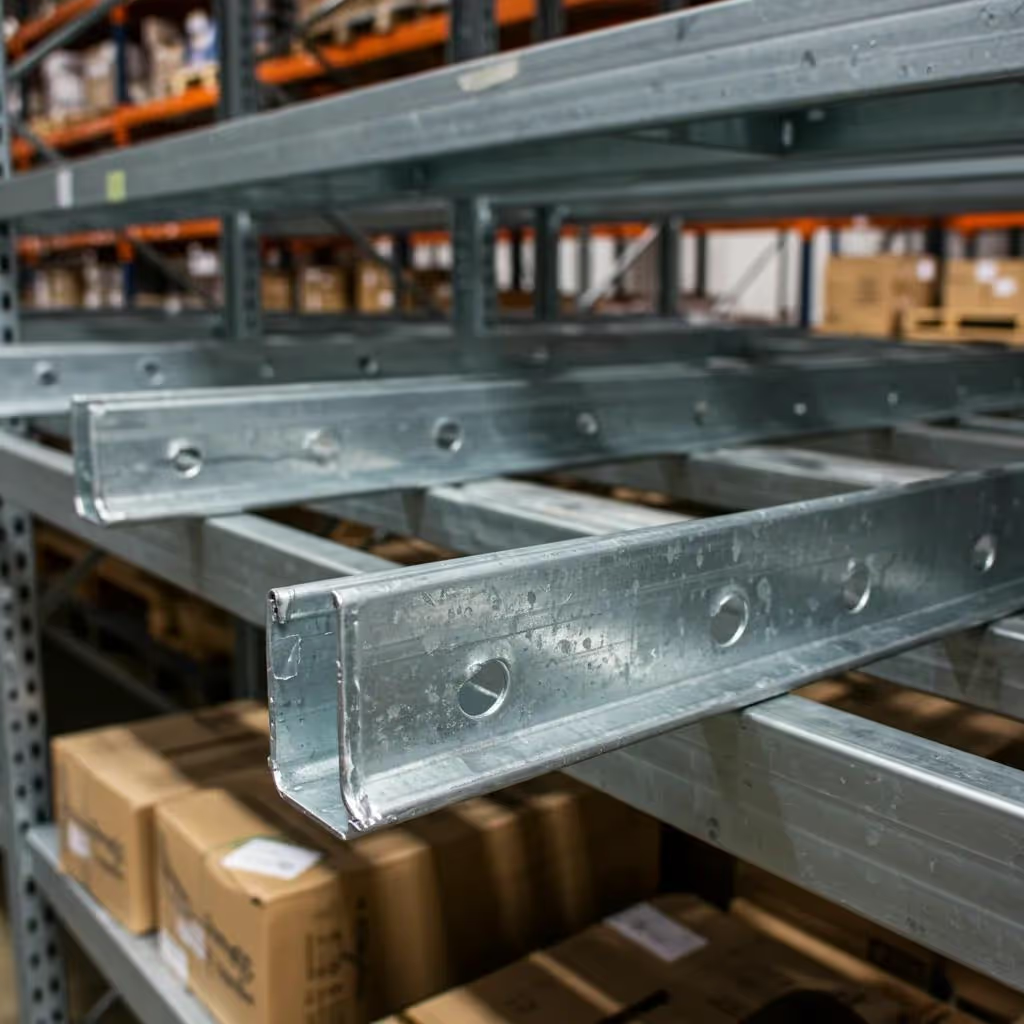
Galvanised steel racking applies a zinc coating to structural components, creating a barrier that prevents rust formation and extends service life in corrosive conditions. Zinc sacrificially corrodes before underlying steel, maintaining rack integrity even when coating experiences abrasions. This protection is key for supplies exposed to moisture, certain chemicals, and cleaning solvents.
Galvanising also requires minimal maintenance. Unlike painted or powder-coated surfaces that can chip and require touch-ups, a hot-dip zinc layer regenerates protective properties across small scratches. Warehouses near wash-down stations or outdoor loading docks benefit from galvanised racks that stay rust-free for decades.
What Is Galvanised Steel and How Does It Protect Inventory?
Galvanised steel is carbon steel whose surface has been submerged in molten zinc, forming a metallurgical bond that resists oxidation. This process creates a uniform coating that seals welds, corners, and interior channels where corrosion typically initiates. As a result, various items stored on galvanised racks remain free of rust stains and pitting.
The mechanism of protection involves:
- Zinc layer sacrificially corroding before iron in the steel
- Formation of zinc-oxide compounds that self-heal minor coating breaches
- Long-term barrier that prevents moisture, salts, and solvents from reaching steel
This corrosion–resistant barrier preserves both rack and inventory appearance and performance.
Which Storage Environments Benefit Most from Galvanised Steel Racking?
Environments that combine moisture, chemical exposure, and temperature variation accelerate steel corrosion without protective coatings. Galvanised pallet racking excels in:
- Outdoor or semi-outdoor loading bays where rain or humidity is frequent
- Indoor wash-down areas used to clean tools and equipment
- Chemical storage zones containing various solvents or cleaning agents
- Cold storage rooms prone to condensation on surfaces
Galvanised steel’s resilience in these scenarios reduces maintenance, minimises rack replacement, and safeguards supplies from corrosive damage.
Why Is Stainless Steel the Premium Choice for Chemical-Resistant Racking?
Stainless steel pallet racking offers inherent corrosion resistance through chromium-rich alloys, making it ideal for sterile or highly corrosive storage environments. Unlike coated steels, stainless grades resist pitting, crevice corrosion, and chemical attack without additional finishes. This alloy’s longevity can exceed 25 years, supporting long-term cost savings despite higher initial investment.
The protective mechanism arises from a passive chromium-oxide film that forms spontaneously on stainless surfaces. This film self-repairs if mechanically damaged, ensuring continuous defense against moisture, acids, and alkalis encountered in warehouses. In sterile or medical supply areas, stainless steel keeps environments hygienic while maintaining rack strength under heavy loads.
What Stainless Steel Grades Are Best for General Storage?
Two grades dominate racking applications: 304 and 316. Grade 304 contains 18% chromium and 8% nickel, delivering broad corrosion resistance for most warehouse conditions. Grade 316 adds 2–3% molybdenum, boosting resistance to chlorides, acids, and industrial solvents common in supply chains.
Key grade attributes include:
- Grade 304: Excellent overall corrosion resistance and cost-efficiency for indoor storage
- Grade 316: Superior chemical resistance in high-salinity or solvent-rich environments
Selecting between these grades aligns rack performance with the specific chemical exposures typical in operations.
How Does Stainless Steel Resist Corrosion and Chemicals in Warehouses?
Stainless steel resists corrosion through a self-passivating surface film of chromium oxide that prevents oxygen diffusion and steel oxidation. When items exude cleaning agents, acids, or sealants, this oxide layer reduces chemical attack by:
- Inhibiting chloride-induced pitting and crevice corrosion
- Withstanding acidic and alkaline solutions without degradation
- Maintaining structural integrity under continuous moisture exposure
This innate chemical resistance preserves rack aesthetics, prevents contamination of components, and extends service life beyond coated alternatives.
What Are the Benefits and Limitations of Powder-Coated Steel Pallet Racking?
Powder-coated steel applies a dry polymer finish electrostatically and cures it under heat, producing a uniform, scratch-resistant surface that enhances rack durability and appearance. The coating shields steel from moisture and abrasion while offering customisable colors for warehouse organisation. For warehouses, powder coating reduces rust initiation points and simplifies cleaning around stored items.
However, powder coating can chip under heavy impact or forklift collisions, exposing bare steel to corrosion. High-abrasion zones and chemical storage areas may wear coatings faster than galvanised or stainless alternatives. Maintenance involves occasional touch-ups and inspection to prevent isolated rust spots from spreading.
How Does Powder Coating Improve Durability and Appearance for Racks?
By encapsulating steel frames in a fused polymer layer, powder coating delivers:
- Scratch, impact, and chemical splash resistance
- UV stability that prevents fading in well-lit warehouses
- Easy wipe-down cleaning without organic solvent damage
These benefits help operations maintain an organised, visually clear storage layout where shelf labels and product color codes remain legible over time. Periodic inspections and targeted touch-ups prolong coating effectiveness and ward off corrosion at high-traffic racking points.
When Is Powder-Coated Steel Ideal for Warehouse Environments?
Powder-coated pallet racks perform best in:
- Climate-controlled indoor warehouses with moderate chemical exposure
- Retail showrooms or distribution hubs where visual appeal reinforces brand professionalism
- Storage areas for light-duty accessories and tools
- Layouts requiring color-coded rack sections for different product sizes or categories
In these contexts, coating maintenance is minimal and the aesthetic and protective advantages support both operational efficiency and corporate image.
Are Aluminum, Plastic, and Wood Pallet Racking Suitable for General Storage?
Alternative materials such as aluminum, plastic, and wood offer niche benefits for diverse inventories but present trade-offs in strength, cost, and longevity. While these options can excel in hygienic, lightweight, or budget-conscious scenarios, they rarely match the durability and load capacity of steel variants.
What Are the Pros and Cons of Aluminum Racking for General Supplies?
Aluminum racks boast a lightweight, corrosion-resistant alloy that simplifies rack relocation and reconfiguration in warehouses. Reflective surfaces also aid visibility in dimmer storage aisles. However, aluminum’s lower modulus of elasticity limits shelf load capacity to around 1,500–2,500 pounds per level, making it unsuitable for heavy items or equipment.
How Do Plastic Pallet Racks Support Hygienic and Chemical-Resistant Storage?
Plastic racking systems use high-density polyethylene or polypropylene to create smooth, non-porous shelving that resists moisture, many solvents, and bacterial growth. These properties suit small-parts bins, trays, and chemical container storage. Load capacities generally range from 1,000 to 3,000 pounds per level, so plastic is best for lightweight or hygiene-critical components rather than bulk storage.
When Is Wood Pallet Racking a Cost-Effective but Limited Option for General Use?
Wooden racks offer the lowest upfront cost for short-term or overflow storage of non-abrasive items. Pine or fir beams can support up to 2,000 pounds per level but degrade under moisture, fungal attack, and repeated forklift impacts. Splintering and fire hazard concerns further restrict wood to dry, low-traffic zones housing non-critical accessories.
How Can Businesses Choose the Best Pallet Racking Material?
Selecting the optimal pallet racking material for general storage involves scoring candidates against load, environment, cost, safety, and longevity criteria. A structured decision framework helps warehouse managers compare key attributes and ensure compliance with industry standards.
What Key Factors Should Influence Material Selection for General Storage?
Businesses should evaluate:
- Maximum expected shelf load including dynamic handling forces
- Corrosion and chemical exposure levels in the storage environment
- Budget allocations for initial investment versus lifecycle maintenance
- Regulatory requirements for rack design, aisle spacing, and seismic bracing
This multi-criteria approach yields a balanced choice that supports both operational resilience and cost control.
How Do Different Materials Compare in Cost, Durability, and Corrosion Resistance?
Below is a comparison of core pallet racking materials against warehouse requirements:
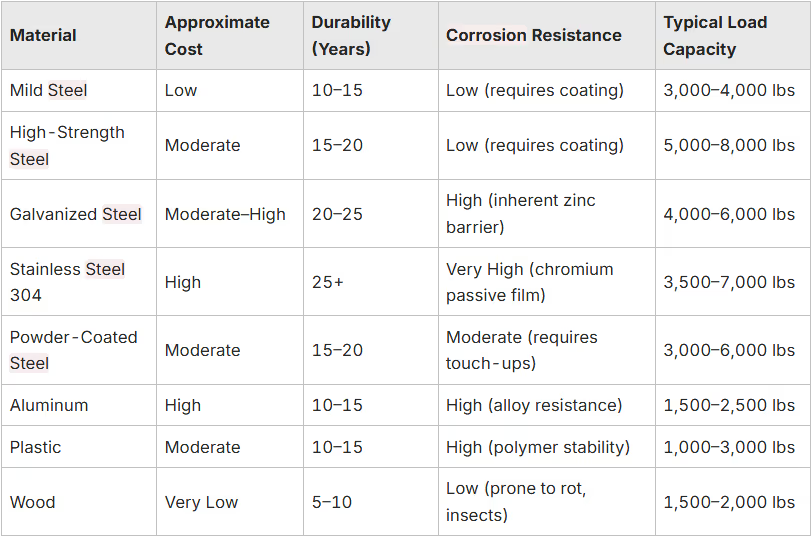
What Safety Standards and Compliance Should Warehouses Follow?
Facilities must adhere to federal and industry guidelines for pallet racking design, installation, and inspection. Key standards include:
- RMI (Rack Manufacturers Institute) design and testing specifications
- OSHA regulations for clear aisle widths, rack end-protectors, and anchoring
- Local seismic codes for bracing in earthquake-prone regions
- ANSI MH26.2 wire mesh decking requirements for fire safety and load support
Compliance ensures worker safety, minimises liability, and enhances insurance eligibility for general supply operations.
What Pallet Racking Accessories and Decking Options Optimise General Supply Storage?
Accessories and decking choices further refine pallet racking performance by securing various items and improving organisation. Proper accessory selection extends material benefits and enhances warehouse safety.
How Do Wire Mesh and Solid Decking Support Varied Inventory?
Wire mesh decking consists of welded steel panels that allow light, air, and sprinkler water to pass through, reducing fire risk and dust accumulation. These open-grid panels conform to ANSI standards and support various items, coils, and box bins while preventing smaller items from falling through. Solid decking typically wood or steel plates offers continuous surface support for bins, crates, or small loose fittings that require stable platforms.
Which Accessories Improve Safety and Organisation in Racking Systems?
Essential racking accessories for general supply storage include:
- Upright protectors to absorb forklift impact and safeguard frame legs
- Backstop bars and end-guards to prevent items from rolling off pallet beams
- Dividers and product rests to organise bundles of stock by diameter and length
- Label holders and color-coded beam clips for rapid inventory identification
Integrating these components with the chosen rack material ensures that parts remain secure, sorted, and easy to retrieve.
What Future Trends Are Emerging in Pallet Racking Materials for Businesses?
Evolving material science and smart warehouse technology are shaping the next generation of storage solutions. Sustainable initiatives and digital integration promise to enhance efficiency, resilience, and environmental responsibility in supply chains.
How Are Sustainable and Smart Storage Solutions Impacting Warehouses?
Green racking materials such as recycled steel, composite decking made from reclaimed plastics, and low-VOC powder coatings reduce carbon footprints and align with corporate sustainability goals. Radio-frequency identification (RFID)-enabled beams and IoT sensors track rack loading, temperature, and humidity in real time, enabling predictive maintenance and reducing inventory loss.
What New Materials or Coatings Could Revolutionise Pallet Racking?
Innovations on the horizon include nano-ceramic coatings that provide ultra-thin, scratch-proof surfaces resistant to harsh solvents, and hybrid metal-polymer composites that blend steel strength with polymer corrosion immunity. Self-healing paint systems and smart alloys that adjust stiffness under load are under development, promising pallet racking systems that autonomously adapt to inventory demands.
Businesses that evaluate these emerging options early can secure competitive advantages in durability, safety, and operational insight.


.svg)



